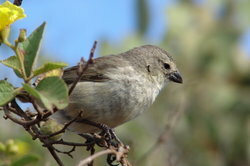Splitting selection explained using the example
With his evolutionary research on the Galapagos Islands, Charles Darwin is still one of the most important founders of the modern understanding of biology. His survival of the fittest is probably the most cited principle in biological sciences. He also coined the concept of splitting selection. But what exactly does this mean and what is the best example to illustrate the theory?

What is meant by disruptive selection
- You may know that the biological concept of selection means selection in the evolution designated. A distinction is made between natural, sexual and artificial selection.
- The natural selection here means the Darwinian survival of the fittest, which means that the reproductive success of weaker species does not occur.
- On the other hand, you probably know sexual selection from your own experience. The point here is that sexual partners choose each other according to certain characteristics that they consider to be particularly important.
- After all, artificial selection means that the selection does not take place naturally, but is made by humans, for example when breeding animals.
- What is interesting for you now is that the concept of selection can be further differentiated in terms of levels and modes of action. In biology, selection modes of action are understood as transforming, stabilizing and disruptive selection.
- The term splitting selection is used as a native synonym for the latter and can thus ultimately be described as one of three possible effects of selection.
- The special selection effect of the splitting selection can now be seen in that the most common characteristics of a living being decline. The reason for this can, for example, be predators or diseases. There is such an advantage for such individuals with rare characteristics because they can occupy ecological niches.
- A rodent that can climb, for example, although this is not really suited to its species, has a survival and evolutionary advantage if there are too many predators on the ground.
The term "selection types" comes from the theory of evolution, a branch of ...
Splitting elite using the popular example of Darwin's finch
- During Darwin's stay on the Galápagos Islands, he dealt extensively with the species of Galápagos finches. You too have probably heard of birds, since they are considered the standard example of segregated selection.
- So it concerns with the finches to animals that were brought to the islands by storms and thus as Founder population can be designated after no individuals of their kind on the volcanic islands before lived
- The fact that the founder finches were the only ones of their kind favored their evolution. For example, there was no competition in foraging for food and just as little opposition, as the animals on the islands had hardly any predators. The huge area available to the finches for breeding also benefited the population.
- Since the finches reproduced rapidly for the above reasons, competition arose relatively early after they had overpopulated the island. Many of the finches finally flew out and populated other islands of the Galápagos Archipelago, whereby the individual "emigrants" adapted to the conditions of their new settlement area. There was a disruptive selection, whereby the ecological niches that were vacant on the individual islands were occupied.
- Subspecies of the same finch species originally developed on the individual islands as a result of the splitting selection. After some birds had migrated back to the island of origin, they coexisted there problem-free with the original species because after the disruptive selection they are genetically different from each other were isolated.
- The finches that had migrated back also occupied new niches, so there was a second splitting selection. As a result, 14 different finch species were formed on the island of origin, which coexist with one another without competition.
In conclusion, we would like to point out an error of interpretation in Darwin's work, which is found in the modern biology is mentioned more and more often. Darwin mentioned the Survival of the Fittest only 3 times in his treatise, while the principle of cooperation was mentioned after almost every sentence. So what Darwin really found and wanted to prove was intra-species collaboration, and disruptive selection is a good example of that.
How helpful do you find this article?


